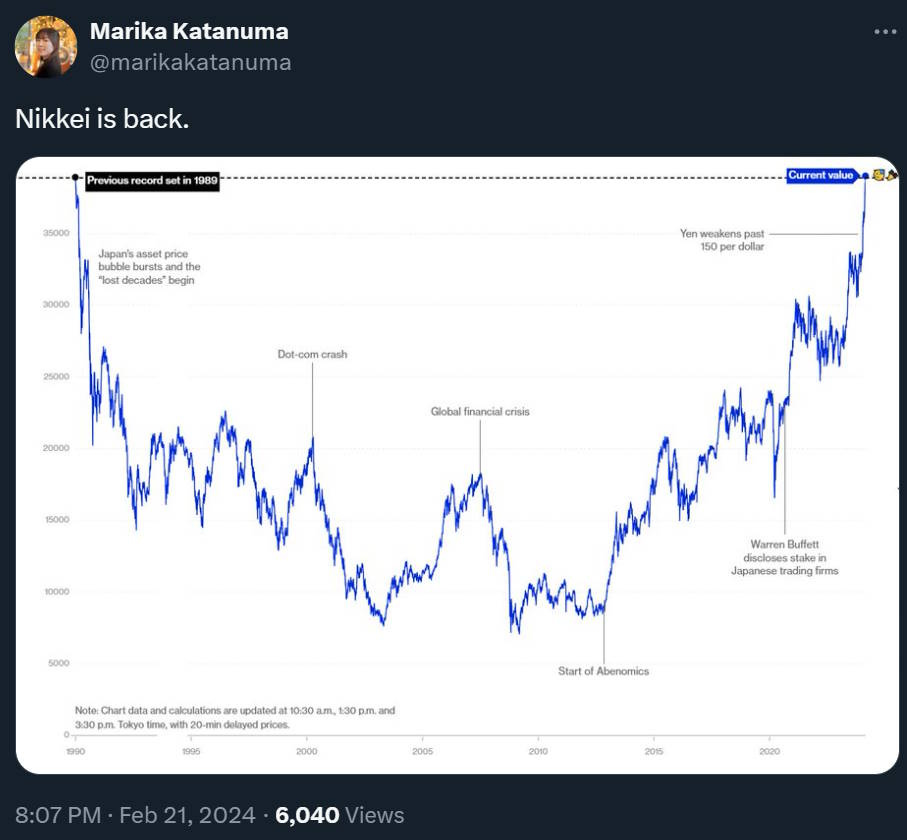Japan isn't quite "back", but it has a fighting chance
Here are some ideas for what it can do to be truly "back".
There was some reason for cheer among Japanese commentators today. The Nikkei 225, Japan’s flagship stock index, finally reattained its previous peak from 1989:
(Note: Technically this isn’t adjusted for inflation, but since Japan hasn’t actually had much total inflation since 1989, that doesn’t make much of a difference.)
Bloomberg’s detailed breakdown shows that the rally over the past year has been driven entirely by foreign buyers. But the foreign buyers probably have the right idea — most Japanese companies still look very cheap compared to the value of their assets.
Unfortunately, a country can’t eat its stock market; Japan’s real economy is looking much more anemic. The country experienced a surprise recession in late 2023, with manufacturing and exports both looking very weak. The country lost its spot as the world’s third-biggest economy at market exchange rates, falling behind Germany (whose economy is also pretty weak). Economists are pessimistic, predicting further economic shrinkage in early 2024.
Still, there are some reasons to be optimistic about Japan’s economy in general. First, the country is finally taking its own defense seriously — defense spending surged from 5.4 trillion yen in 2022 to 7.95 trillion yen in 2024. That’s still only about 1.5% of GDP, but the rapid increase is pretty stunning. Defense spending will stimulate manufacturing, but will also give Japan the chance to build its own military-related tech industries. More fundamentally, it demonstrates that Japan’s leaders realize the magnitude of the threat China poses, and realize that they need economic growth in order to fund a more robust defense.
Second, Japan is bringing in large numbers of foreign workers to ease its labor shortage:

Now, this could end up causing trouble down the road; unlike the U.S., Japan is not a nation of immigrants and does not have much experience assimilating large numbers of foreigners. The Japanese public fears that immigration will lead to an increase in crime and social disorder, and they’re probably right to some extent. So I do expect an anti-immigration backlash at some point. But for now, the inflow of workers is helping to bolster the economy.
Meanwhile, Japan’s fertility rate is low, but at around 1.4 it’s still much higher than China or other East Asian nations, and the country has had some modest success boosting birthrates.
Finally, the big international push to de-risk from China should end up benefitting Japan. Asia isn’t going to be displaced as the world’s electronics manufacturing mega-cluster, so Asian countries other than China are going to be the biggest beneficiaries of the de-risking trend.
So anyway, Japan is in an interesting place right now — some trends are pointing in the right direction and some in the wrong direction. Japan’s policymakers and business leaders need to take action to reinforce the strengths and shore up the weaknesses. Here are some ideas about how to do that. The first two ideas focus on industrial policy, which was a Japanese strength in the past, and which I think could serve it well again.
Use FDI to reclaim Japan’s position in the electronics supply chain
If there’s one lesson I’ve taken from reading about a bunch of successfully developing countries, it’s that foreign direct investment is better and more important than people give it credit for. Economic research strongly supports this. Some small rich economies, like Singapore and Ireland, were basically built by FDI, and their industrial policies are almost entirely focused on courting foreign investors. But even big countries like China managed to learn a huge amount from foreign companies who set up shop there.
Industrialists have often underrated FDI. Japan and South Korea succeeded in autos and electronics by developing their own brands, largely refusing to make things for foreign brands. This allowed their companies to retain the profits, control the intellectual property, and choose to keep the most valuable parts of the supply chain in the country.
But in recent decades, this “do everything in-house” strategy began to fail Japan. First the U.S., then Taiwan and South Korea took over semiconductor design and fabrication — the most high-value and high-tech parts of the electronics supply chain. Japan promoted multiple national champions and consolidated some of its existing firms to try to increase competitiveness, but nothing worked. Samsung, TSMC, and Intel ruled the roost, and Japanese chipmakers largely became also-rans.
In order to get back in the game quickly, Japan needs to change tactics, abandoning what failed and learning from the companies that succeeded. It needs to entice other countries — especially South Korea and Taiwan, but also the U.S. and Europe — to build fabs in Japan.
This will facilitate learning — Japanese workers who work at TSMC or Samsung factories will learn lots of useful tricks. It will foster human capital; the new fabs will train a large and expanding semiconductor workforce, facilitating follow-on investments from other countries. It will facilitate entrepreneurship, as homegrown Japanese semiconductor startups spring up to sell things to the fabs, use the fabs’ chips to make electronics, and eventually make chips themselves. And it will boost exports, because foreign companies making chips in Japan will want to sell them overseas.
Luckily, Japan has a ton of natural advantages that make it the perfect place to build chip fabs. I went over these in a post a couple of months ago:
The first four reasons are:
The weak yen (and low interest rates)
A lot of high-quality semiconductor tools and materials companies that still exist in Japan
A highly skilled semiconductor workforce that will work for relatively low wages
Pro-development land use policy and few NIMBY barriers
At this point, building chips in Japan is almost an arbitrage.
I also added government support and entrepreneurs’ hunger and ambition as the fifth and sixth advantages. But these are, of course, highly contingent. The Japanese government is spending a lot of money on the industry, but it needs to make a conscious choice to do whatever is necessary to court FDI, including building new infrastructure and providing specialized education and training as necessary.
Japanese businesses, meanwhile, have to be determined to win back their traditional place in the global electronics supply chain. That success will require humility — an admission that South Korean and Taiwanese companies have become the industry leaders, and a willingness to learn from them.
Update: Here’s a good Bloomberg article on how TSMC managed to build a fab in Japan far more quickly and efficiently than they did in America. Basically, government support, low wages, a strong work ethic, and assistance from a local parther (Sony) all contributed to the stunning success.
Develop a software industry, an EV industry, and a military-industrial complex
Beyond chips, there are other important industries Japan should try to promote. The first of these is software. Like Europe, Japan has fallen behind the U.S. and China in terms of creating new highly productive software businesses. Japan doesn’t overregulate software like Europe does, but there is still no Japanese equivalent to Microsoft, Amazon, Meta, OpenAI, and so on.
There are a number of reasons for this, but a big one is that Japanese companies tend to create their software in-house instead of purchasing it from specialized third parties. Japanese software startups are ambitious and talented, but they have a hard time finding Japanese business clients, so they can’t scale up. Meanwhile, companies that keep software in-house end up with crappy software, since it isn’t their core competency as firms. This ends up hurting Japanese hardware manufacturing as well.
The solution here is for the Japanese government to incentivize hardware companies to purchase software from third-party vendors. That will give Japanese software companies a huge business opportunity, and allow them to build up the scale they need to go out and challenge overseas rivals in world markets. On top of that, Japan should try to improve software education.
Another industry Japan needs is EVs. Autos, even more than electronics, have been Japan’s greatest success, but, like Germany, the country’s industry is in grave danger from a technological shift. Japanese companies like Toyota and Nissan are way behind when it comes to EVs, and their sales are starting to suffer as a result. The Japanese carmakers have invested some money in battery EVs, but at the same time they’ve continued to insist that dead-end technologies like hydrogen are a viable alternative.
Japanese companies need to wake up and realize that batteries are just going to defeat everything else on the market. The government can facilitate this realization by increasing Japanese consumers’ demand for EVs. And the way to do that is to build lots and lots and lots of battery charging stations throughout the country.
Right now, Japan has very few charging stations, meaning that Japanese people don’t want to drive battery-powered cars, meaning that Japanese car companies can’t sell EVs in their own domestic market. If the Japanese government builds a ton of charging stations, this vicious cycle will reverse itself, and Japanese car companies will be scrambling to switch to batteries.
Finally, Japan’s increased defense spending gives it the opportunity to create a military-industrial complex. Defense-related research has been an incredible industrial boon to the U.S., creating tons of cutting-edge technologies that U.S. companies have then capitalized on. Japan needs to study the DARPA model and create something similar on its own shores. And defense spending can revitalize Japan’s lagging universities, including by hiring researchers from overseas.
Reform Japanese corporate culture
So far I’ve been talking about industrial policies that Japan can use to boost key industries and regain technological leadership. But I fear that most of that will come to naught unless Japan addresses the root cause of its long decades of economic underperformance. That root cause is Japan’s broken corporate culture.
In a post back in 2022, I tried to lay out exactly what I thought was wrong with Japan’s corporate culture, and how to fix it:
My suggestions were:
Encourage mid-career hiring of managers from other companies, instead of promoting everyone in-house
Encourage employees to do some of their work from home (hybrid work)
Stop using government money to bail out failed companies
The first of these, mid-career management hiring, addresses two fundamental problems with corporate Japan. First, it will enhance idea diffusion and recombination across firms. Technologies and business models spread from company to company via human beings who go to work for one company and then work for a different company. Japan’s traditional lifetime employment system keeps good ideas siloed within individual firms, preventing them from benefitting Japan, Inc. at large.
Second, mid-career hiring will help to combat the problems of an aging society. Research shows that aging is moderately bad for productivity growth. One likely reason is that elderly managers are less capable of understanding the importance of new technologies, new markets, and new business models. When most of the people in a society are old, as in Japan, old guys clog the ranks of upper management at companies. Corporate Japan, with its traditional focus on promoting managers up through the ranks as they age, has become a gerontocracy. Mid-career hiring can shake up that gerontocracy, because management hires will tend to be selected for talent rather than tenure.
Hybrid work will be another big productivity-booster for Japanese companies. Traditionally, Japanese companies prize hours of work input over actual results, and this needs to change. Right now, Japanese offices are open-plan affairs where everyone sits there trying to look busy. It’s no coincidence that Japan’s white-collar productivity is some of the lowest in the developed world. Cubicles would help, but letting workers take some of their work home with them would do far more. At home, the goal of work is not to look busy, but to accomplish a specific task, in order to please your boss on the following day.
Thus, hybrid work will help Japanese companies shift their attitudes toward the fundamental goal of work. It would also help parents balance work and family more effectively, which would probably help raise the fertility rate.
Finally, the Japanese government needs to stop using a bunch of so-called “stimulus” slush funds to bail out failed companies. Instead, its industrial policy should be focused on boosting new, more productive companies.
Japanese business leaders should see the wisdom of mid-career management hiring and hybrid work, and implement these changes on their own. But the Japanese government, with its strong and capable bureaucracy, can also do quite a lot in this regard. In the 2010s, Japan’s Ministry of Finance introduced a new Corporate Governance Code that probably helped push Japanese companies to become much more profitable. Now, either the Ministry of Finance, or the Ministry of Economy, Trade, and Industry, or both of them acting in concert need to intervene to push Japanese companies to become more efficient.
To sum up, I think that what Japan really needs in order for its economy to be fully “back” is to rediscover the zeal for industrial policy and cultural transformation that it had during its catch-up years in the 1960s and 1970s. The specific policies just need updates for the modern age. Instead of shutting out FDI, Japan now needs to draw it in. Instead of building a corporate culture based on lifetime employment and seniority promotion, it needs to build one based on flexibility in hiring and in work hours. And instead of clinging to fading dominance in the industries of the 1970s, it needs to muscle in on the industries of the 2020s.
I believe Japan can do it. But it’s not going to be easy or quick.






People have been bitching about Japanese corporate culture for decades. It's unrealistic to think that the government can cause anything more than a minor shift in the system.
A much fruitful would be, as you said, FDI. Foreign businesses can bring Western workplace and management practices into Japanese. The government should also encourage foreign investment into a Startup ecosystem. New ambitious firms will naturally select for the portion of the population that want to break free from the Japanese system. When Japan is full foreign businesses and start ups, the local investors and governments can let these old companies die more easily as opposed to propping them up with public money.
In the 80s and 90s you saw Western firms hire contract manufacturing to Asian companies while keeping the higher value added activities like engineering design, marketing and after sale services in house. Now, since the 2010s, you're seeing Asian contract manufacturers hire or buy out western design and marketing firms to increase their competitiveness. An interesting reversal of fortunes.